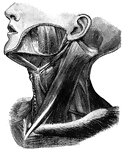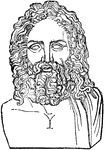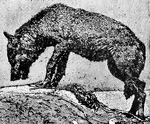
Wolf
"Wolf is the vernacular name of certain species of the genus Canis. The common wolf (C. lupus) has very…

Hairy Nosed Wombat
"The Wombat is a burrowing marsupial from Australia and Van Dieman's Land, and the islands of Bass'…
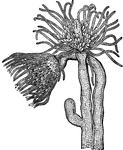
Tubularia coronata
"The Tubularidae are a family of hydroid polypes are for the most part social animals, frequently possessing…
Spinal column
"The spine or backbone, serves as a support for the whole body. It is made up of a number of…

Scapula
"The shoulder-blade is a large, flat, three-sided bone, which is placed on the upper and back…
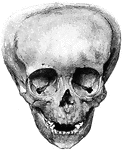
Deformed skull
"Showing how the Bones of the Skull may be artificially deformed by "head-binding." From the photograph…

Muscles of the Back and Shoulder
"Some of the Larger Muscles on the Back of the Shoulder and the Arm." — Blaisedell, 1904
Thigh Muscles
"Some of the Larger Muscles on the back of the Thigh. Powerful tendons at the hip and on the back of…

Muscles of the neck and back
"One of the Deep Layers of Muscles of the Neck and the Back." — Blaisedell, 1904

Back view of the adult mouth
"The head is represented as having been thrown back, and the tongue drawn forward. A, B…
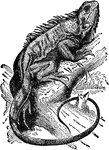
Iguana
"Iguana is a genus of saurian reptiles, natives of Brazil, Cayenne, the Bahamas, and neighboring localities…
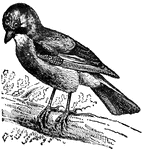
Jay
"Jay is the popular name of a species of birds belonging to the crow family, of a vinous red color;…

Diagram of the circulation of the blood
"R.A., right auricle; L.A., left auricle; R.V., right ventricle; L.V.,…
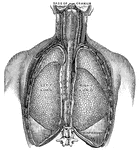
Lungs
"Relative Postion of the Lungs, the Heart, and Some of the Great Vessels belonging to the latter. A,…

Vertical Section of the Back
"The spinal column below the twelfth dorsal vertebra at A has been removed, as well as the…
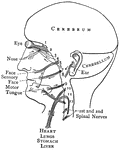
Distribution of the Cranial Nerves
"The cranial nerves are thus arranged in pairs: 1, olfactory nerves, special nerves of smell; 2, optic…
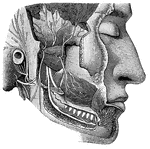
Cranial Nerves
"Dental Branch of One of the Divisions of the Fifth Pair of Cranial Nerves, supplying the Lower Teeth.…

Superficial Nerves of the Head
"Showing some of the superficial nerves on the left side of the neck and the head. A few superficial…

Superficial Nerves of the Forearm and Hand
"Superficial, or Cutaneous, Nerves on the Back of the Left Forearm and Hand." — Blaisedell, 1904
Great Nerve
"A Great Nerve (Posterior Tibial) on the Back of the Leg, with its Accompanying Artery of the Same Name."…

Lumpfish
"The Lump Fish, or Sucker, is named from the clumsiness of its form. The back is arched and sharp, the…

Tomb of Midas
"Midas was, in Greek legend, a King of Phrygia. For his kindness to Silenus he was promised by Dionysus…

Miter
"Miter, or Mitre, is a form of head-dress worn by the inhabitants of Asia Minor; a head-band. In religion,…
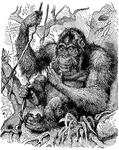
Orang Outang
"The Orang Outang is the Mias of the Dyaks; also known as the 'wild man of the wood.' It is a dull,…

Hand seat
"Improvised Hand Seats: the Three-Handed Seat. THe usefull three-handed seat is made by one bearer grasping…

Palmistry
"Palmistry, or Chiromancy, is the art which professes to discover the temperament and character of anyone,…

Pericles
"So long as Pericles stood at the head of Athens in time of peace, he governed it with moderation and…
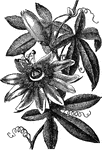
Passion Flower
"Pasiflora is the passion-flower. Generally climbing herbs or shrubs. Fruit succulent, seeds many. Found…
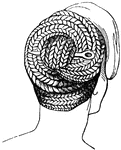
Acus
"A needle, a pin. Pins were made not only of metal, but also of wood, bone, and ivory. They were used…

Aegis
"signifies, literally, a goat skin. According to ancient mythology, the aegis worn by Jupiter was the…
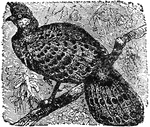
Pheasant
"The Pheasant is one of the most highly prized game birds. The adult male pheasant is a beautiful bird,…
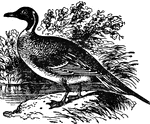
Pintail Duck
"The Pintail Duck has the upper parts and flanks ash, with narrow stripes of black; under parts white;…

Polecat
"The Polecat is one of the Mustelinæ, akin to the marten, but with a broader head, a blunter snout,…

Pompeiian House
"House construction consists mainly of concrete or brick, and sometimes of stone blocks, especially…
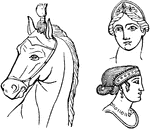
Amphyx
"Amphyces, Frontlets. A frontal, a broad band or plate of metal, which ladies of rank wore above the…
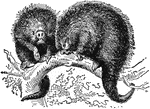
Prehensile Tailed Porcupine
"The Porcupine is a rodent quadruped. The North American porcupine is about two feet long, and of sluggish…

Hystrix Crystata Porcupine
"The Porcupine is a rodent quadruped. The North American porcupine is about two feet long, and of sluggish…
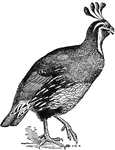
Lophortyx Californicus Quail
"The Quail is a small game bird; the Virginia species is common in North America, and so far south as…
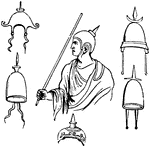
Apex
"A cap worn by the flamines and salii at Rome. The essential part of the apex, to which alone the name…
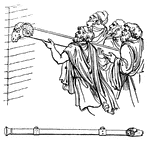
Aries
"The battering-ram, was used to batter down the walls of besieged cities. It consisted of a large beam,…
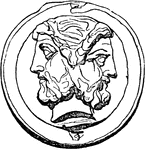
As
"The unit of value in the Roman and old Italian coinages, was made of copper, or of the mixed metal…

As
"The unit of value in the Roman and old Italian coinages, was made of copper, or of the mixed metal…

Sawfish Head
"The Sawfish is so called from the saw-like weapon into which the snout is produced. They are common…

Hooded Seal
"The Seal, of the family Phocidæ, or seal tribe, are, of all four-limbed mammiferous animals,…

Shoveler Duck
"The Shoveler is the broadbill or spoonbill duck, widely distributed over the Northern Hemisphere. Length…

Sphinx
"Sphinx is a Greek word signifying 'strangler,' applied to certain symbolical forms of Egyptian origin,…
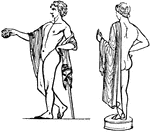
Chlamys
"A scarf, denoted an article of the amictus, or outer raiment of the Greeks. It was for the most part…

Corona
"A crown, that is, a circular ornament of metal, leaves, or flowers, worn by the ancients round the…

Corona
"A crown, that is, a circular ornament of metal, leaves, or flowers, worn by the ancients round the…
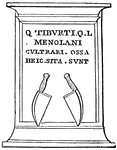
Culter
"A knife with only one edge, which formed a straight line. The blade was pointed, and its back curved.…
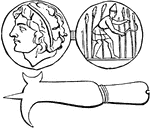
Falx
"A sickle; a scythe; a pruning knife or pruning hook; a bill; a falchion; a halbert. As culter denoted…
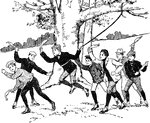
Sling the Monkey
"Sling the Monkey is a capital game, and can be played anywhere where there are trees. One player who…

Ring the Bull
"This amusing game requires more care and delicacy of touch than at first seems to be the case. The…

Cudgel Game
"Here is a new game, which is causing a great deal of amusement at social gatherings in Europe. Two…


